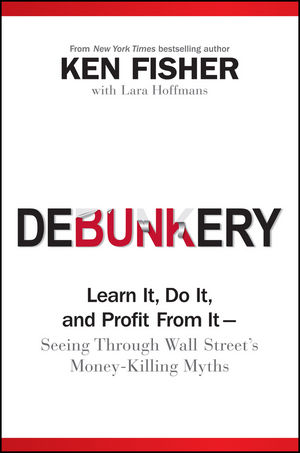Debunkery: Learn It, Do It, and Profit from It -- Seeing Through Wall Street's Money-Killing MythsISBN: 978-0-470-28535-0
Hardcover
256 pages
October 2010
 |
||||||
Connect with Wiley Publicity
Ken Fisher’s DEBUNKERY
Learn It, Do It, and Profit From It—Seeing Through Wall Street’s Money Killing Myths
By New York Times Bestselling Author Ken Fisher
With Lara Hoffmans
Legendary investor Ken Fisher’s latest book DEBUNKERY: Learn It, Do It, and Profit From it—Seeing Through Wall Street’s Money-Killing Myths (Wiley; October 2010; $27.95; hardcover) challenges and refutes common, widely held investing myths and misperceptions; maxims that rob investors and kill profits. “Every investor, me included, makes lots of mistakes—but a huge part of success is avoiding common errors most investors make repeatedly—and that’s the focus of this book,” says Ken Fisher.
“Folks have a romantic notion about ‘beating the market’,” says Ken Fisher. “A lofty goal—and possible, though difficult—but most investors not only don’t beat the market, they don’t match the market or come even close.” DEBUNKERY shows readers why and how to avoid these oft repeated mistakes.
DEBUNKERY comes in bite-size chunks---where you can read one chapter or many—and not necessarily in any given order. Readers should feel free to skip around and dive in anywhere. Ultimately, it is meant to deliver short, pithy lessons that are applicable immediately.
Among many myths and superstitions, DEBUNKERY disproves:
- One Big Bear Market and You’re Done. Bunk. The bigger a bear market, the bigger and swifter the returns can be—and usually are—off the bottom. Bear markets can be big, but don’t imply smaller subsequent bull markets—contrary to myth—just the opposite. .
- Make Sure It’s A Bull Market Before Diving In. Bunk. There is never an “all clear” sign. If there were everyone would beat the market. The opportunity cost of missing a bull market’s first few months is massive and lasting. So be sure not to miss it—or you’ll regret it later.
- A Good Con Artist Is Hard To Spot. Bunk. In reality, it is easy to spot a potential fraudster and Ken Fisher shows readers five sure signs to be on the lookout for, and details how to make sure what happened to Bernie Madoff’s victims never happens to you.
- Covered Calls Have You Covered. Bunk. The name “covered calls” is comforting! But the truth is that, despite perception, covered calls are extremely risky. Debunkery proves it.
- Sell in May. Bunk. Everybody’s heard, “Sell in May and go away.” But its provably wrong and bad advice. This is easy to prove but the tool Debunkery uses to prove it can be used to disprove lots of other common myths. Learn it and have fun with it to your profit.
- Low P/Es Mean Low Risk. More bunk. People tend to think low price-to-earnings (P/E) ratios mean low risk for single stocks and the market as a whole. It’s an almost universal, near-religious belief that “everyone knows.” But it’s just wrong. Using P/E’s to forecast risk and return over any reasonable time period is about as useful as a Ouija board.
- High Unemployment Is A Stock Market Killer. No. Unemployment is a late lagging indicator. It doesn’t predict anything. Ever! See how and why! High unemployment scares many from opportunities but it should always be ignored. Debunkery shows the proof.
- Stocks Love Lower Taxes. Bunk again. Folks love fretting over taxes. It’s a national pastime. But there’s no evidence that a tax cut or hike has a predictable outcome on future stock levels. Other forces are bigger. You should skip taxes and focus where it counts.
Once you intuitively accept that commonly accepted investing wisdom often isn’t wise and learn to debunk myths to avoid common and widely repeated mistakes, you improve your odds. Through DEBUNKERY you will still make mistakes but your overall investing success should improve and your portfolio should look greener in the years ahead. Learn more at http://www.debunkery.com
About the Authors
Ken Fisher is best known for his “Portfolio Strategy” column in Forbes magazine, where over 26 years of high-profile calls make him the fourth-longest-running columnist in Forbes’ history. He is the founder, chairman, and CEO of Fisher Investments, an independent global money management firm managing over $37 billion (as of 9/30/2010). Fisher is ranked #252 on the 2010 Forbes 400 list of richest Americans. In 2010, Investment Advisor magazine named him one of the 30 past years’ 30 most influential industry individuals. He has written six prior books, including New York Times and Wall Street Journal bestsellers: The Only Three Questions That Count, The Ten Roads to Riches, and How to Smell a Rat. For more visit http://www.ken-fisher-investments.com
Lara Hoffmans is a manager and senior editor at Fisher Investments and co-authored The Only Three Questions That Count, The Ten Roads to Riches, and How to Smell a Rat. She graduated from the University of Notre Dame.
About Fisher Investments Press
Fisher Investments and John Wiley & Sons, Inc. launched Fisher Investments Press in 2007 to offer investing education for a wide and diverse audience. The series offers the full spectrum of investors, from novice to professional to investing enthusiast, a tool set to help them become better investors. Fisher Investments Press has published 9 titles to date, including 7 investment sector guides. For more information visit http://www.fisher-investments-press.com
About Fisher Investments
Founded in 1979 by Ken Fisher, Fisher Investments is an independent, global money management firm headquartered in Woodside, CA. Fisher Investments currently manages $37 billion across two principal business units: Fisher Investments Institutional Group and Fisher Investments Private Client Group. These units serve diverse groups of global clients, including corporate, public and multi-employer pension funds, foundations and endowments, insurance companies, healthcare organizations, governments, and over 24,000 high net worth individuals. Fisher Investments is a registered investment adviser with the Securities and Exchange Commission under the Investment Advisers Act of 1940. For more information visit http://www.fisherinvestments.com



